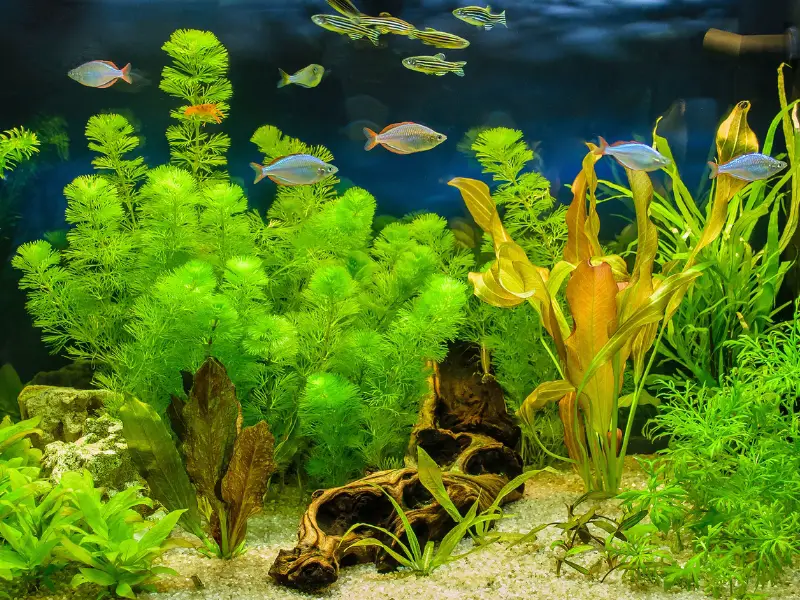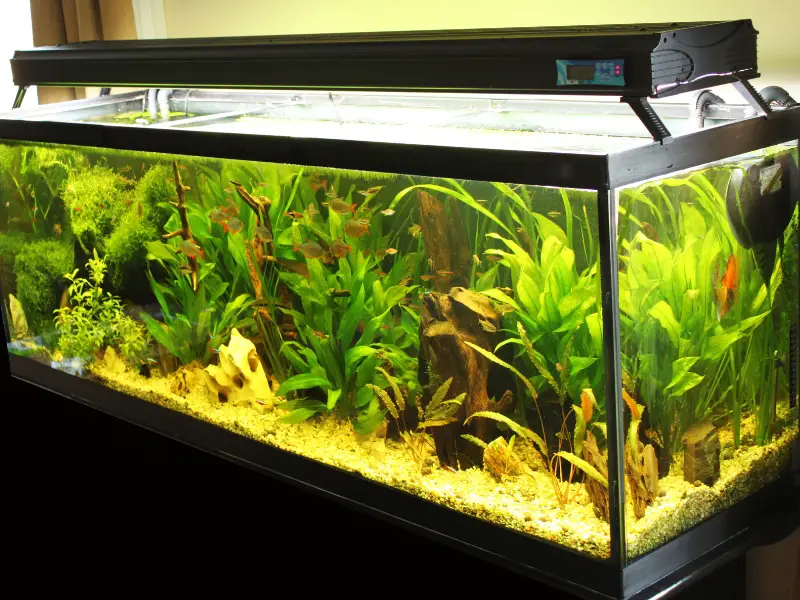Have you ever caught a glimpse of a fascinating aquatic plant that resembles a bunch of tiny bananas?
If so, you’ve stumbled upon the remarkable banana plant, also known as Nymphoides aquatica.
As a beginner-friendly aquarium plant, the banana plant adds a unique charm to your setup with its vibrant green leaves and distinctive tubular roots.
Keep reading to learn everything you need to know to care for, plant, and propagate banana plants in your aquarium.
Banana Plant Overview
| Scientific Name: | Nymphoides Aquatica |
| Common Names: | Aquarium banana plant, banana lily, heart water lily |
| Color: | Green |
| Growth Rate: | Medium |
| Minimum Tank Size: | 10 gallons |
| Placement: | Foreground |
| Substrate: | Sand, gravel, or soil |
| pH: | 6.0 – 7.5 |
| Lightning: | Moderate |
| Water Temperature: | 68 – 82°F |
| Propagation: | Cut off a leaf and let it float in the tank |
| Difficulty: | Easy |
Appearance
The aquarium banana plant features brilliant green leaves and a unique set of tubular roots, resembling a bunch of bananas.
When you take a closer look at your banana plant, you’ll notice that each of the thick green tubers sits directly above the soil, giving it that distinct “banana-like” appearance.
As the plant grows, it may produce a long leaf stem that shoots toward the surface of the tank, providing a visually interesting foreground in your aquarium.
Occasionally, the banana plant may even grow small white flowers just above the water’s surface.
Aquarium Setup

In this section, we will discuss the ideal setup for your aquarium banana plant.
It’s essential to create the right environment, which closely mimics its natural habitat, for the plant to thrive.
Natural Habitat
The banana plant is native to the south and southeast regions of the United States, where it can be found in lakes, ponds, swamps, and slow rivers.
Understanding its natural habitat will help you create similar water conditions in your aquarium.
Lighting Requirements
Provide your aquarium banana plant with adequate lighting to ensure optimal growth.
Good lighting is especially important as it enables the plant to undergo photosynthesis.
Aim for moderate light levels as a balance between simulating the banana plant’s natural habitat and avoiding excessive algae growth.
Water Conditions
Water conditions play a crucial role in ensuring the well-being of your aquarium banana plant.
Maintain a temperature between 68°F and 82°F, imitating the plant’s natural habitat.
A stable pH level between 6.0 and 7.5 is also important for its health.
Make sure there’s gentle water flow around the plant as it’s accustomed to calm waters.
Substrate Choices
When selecting a substrate for the aquarium banana plant, you have a few options:
- Aquarium Gravel: This popular choice provides a stable base and allows for proper water flow around the banana plant’s roots.
- Sand: A sand substrate offers a smooth surface for the plant’s delicate roots, but may not hold it in place as firmly as gravel.
- Soil: Aquatic soil specifically formulated for planted aquariums can provide essential nutrients for the plant’s growth, but may cloud the water initially.
Ensure a minimum of two inches of substrate depth to help anchor the plant and accommodate its root system.
Plant Placement
Choose a spot with good lighting and gentle water flow for your banana plant’s placement.
Depending on your tank size and other plants, the aquarium banana plant can be used as a foreground, midground, or background plant in larger tanks, or even as a background plant for a 5-gallon nano tank.
Remember to sink the plant’s tubers into the substrate, leaving its rhizomes exposed to provide the necessary nutrients.
Caring for Aquarium Banana Plant

Banana plants are a popular choice for aquariums due to their attractive appearance and ease of care.
Here’s how to care for an aquarium banana plant:
Propagation
Propagating your aquarium banana plant is quite simple. Just cut off one of the leaves and let it float in your tank.
Over time, new roots and small leaves will start to appear. Once that happens, you can plant the new growth back into the substrate.
Pruning and Maintenance
Regular pruning helps maintain the health and appearance of your aquarium banana plant.
Remove any yellow or brown leaves, as this indicates poor health or nutrient deficiency.
Be sure to also trim back any overly long roots and occasionally re-anchor the plant with plant weights if needed, to keep it secure in the substrate.
Fertilization
Aquarium banana plants benefit from both liquid fertilizer and root tabs.
Using a liquid fertilizer can provide essential nutrients in the water column, while root tabs placed in the substrate help promote healthy root growth.
It’s important to follow the manufacturer’s instructions to ensure proper dosing and prevent over-fertilization.
Common Problems
Keep an eye on the pH levels in your aquarium, as banana plants prefer a slightly acidic to neutral pH, ideally between 6.0 and 7.5.
If you notice your plant struggling or observe any discolored leaves, test the water parameters to make sure they are within an acceptable range.
Additionally, ensure your banana plant is receiving adequate light, as insufficient light can lead to slow growth and poor overall health.
FAQs About Banana Plant Aquarium
How Do You Propagate a Banana Plant in an Aquarium?
Aquarium banana plants can be propagated from cuttings of established plants.
To propagate a banana plant, cut off a mature leaf from the parent plant and let it float around in the aquarium.
After a few weeks, small roots and leaves will start to appear on the cutting. Once the roots are established, the cutting can be planted into the substrate.
The cutting will grow its own runner stem and tubers, which will eventually develop into a new banana plant.
It’s important to provide proper care, including adequate lighting, water parameters, and fertilization, to ensure that the propagated plant grows and thrives.
Do Banana Plant Float?
Banana plants are not typically known to float in an aquarium.
They are rooted plants that require a substrate to anchor themselves and grow.
However, if a banana plant becomes uprooted or the substrate is disturbed, it’s possible for the plant to float temporarily until it can be replanted.
Additionally, some banana plant species, such as the dwarf banana plant, may have leaves that float on the surface of the water.
Overall, banana plants are not considered to be floaters, but rather rooted plants that require a suitable substrate to grow.
What Is the Aquarium Plant that Looks Like a Banana?
The aquarium plant that looks like a banana is called the banana plant (Nymphoides aquatica).
It is a relatively easy plant to care for and is popular among aquarium enthusiasts due to its unique appearance.
The banana plant has long, narrow leaves that resemble the shape of a banana, hence its name.
It requires moderate to high lighting and slightly acidic to neutral water with a pH of 6.0-7.5.
The banana plant is a rooted plant that requires a suitable substrate to anchor itself and grow.
How Do You Take Care of a Banana Plant?
To take care of a banana plant in an aquarium, you should provide it with adequate lighting, water parameters, and fertilization.
Banana plants require moderate to high lighting and slightly acidic to neutral water. They also require a suitable substrate to anchor themselves and grow.
Provide regular fertilization with a liquid fertilizer that is specifically formulated for aquarium plants.
Prune the plant regularly to prevent it from overcrowding the aquarium and remove any dead or dying leaves.
Banana plants can be propagated by cutting off a stem with a few leaves and planting it on the substrate.
By providing proper care, you can keep your banana plant healthy and thriving in your aquarium.
Related Articles:
